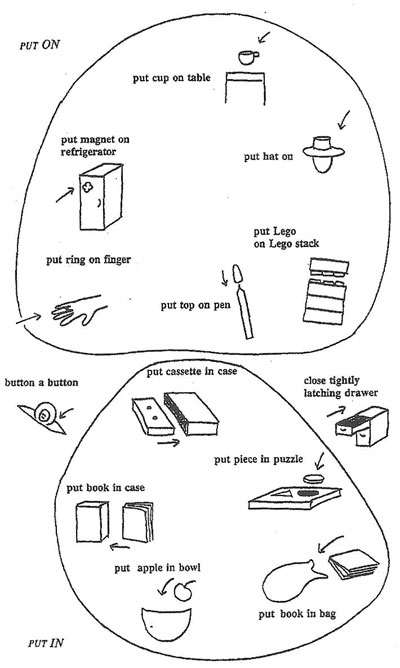Assigned Thursday, February 29, 2008 For Problems 1–4 we assume speakers of American English. Consider the following three words: For each of sugar cookie, software, and prototypical fork, answer (b) and (c) below: Each of the example sentences below contains a different sense of the word branch: Give a brief characterization of each sense exemplified above. Then, draw a polysemy network incorporating the four senses. In your graph identify the central case, and connect nodes for other senses based on how they are extensions of a (central or non-central) case. Hint: Unlike with cases of homophony (e.g. river vs. financial bank), there should be no isolated nodes in your graph. List at least 5 roles/entities and at least 3 events/actions that might belong to each of the following frames: If any of the events are subparts of other events you listed, indicate this. This problem will concern image schemas, a class of frames which deal with spatial relations and motion of objects. Imagine a situation in which a rattlesnake slithers out of a hole, across the ground, and into a house (via the front door). You've already learned how to represent the beginning and end portions of the scenario using the Trajector-Landmark, Container, and Source-Path-Goal (SPG) image schemas. To review, here are definitions for these schemas using Embodied Construction Grammar (ECG), which you will learn more about later in the course: Now, the meanings of the words out of and into are specified with OutOf and Into schemas that evoke Trajector-Landmark, Container, and Source-Path-Goal schemas, binding them together in different ways: Without worrying too much about the notation, take a look at the last three lines of the above schemas. For Into the source is the exterior of the container and the goal is the interior of the container; for OutOf it is reversed. For both Into and OutOf, the path is the portal (which allows passage through the boundary of the container). In our scenario, the roles specified in the above schemas will be bound to fillers representing the entities in context. For example, with OutOf, the landmark/container will be bound to the hole, and the trajector will be bound to the snake. For this problem you are asked to use some new schemas to represent the middle portion of the scenario, in which the snake is in the front yard. Consider the following sentences: Your task is to specify role bindings for the Above, On, and Across schemas as used in these sentences. You may need to use Trajector-Landmark, Container, and/or Source-Path-Goal, as well as:
The illustration above is from a paper by Melissa
Bowerman and Soonja Choi, titled Space under Construction:
Language-Specific Spatial Categorization in First Language
Acquisition. In it you see several actions, most of which are
encoded by the English words "put in" or "put on". In particular, you
see depictions of:
Your task will be to find out how these actions are encoded in another
language. After finding a language consultant fluent in a non-English
language, ask him or her to translate these sentences with the help of
the illustration. (The language should be one that you
are not fluent in yourself, although it is permissible for you to have
some familiarity with it.)
Either you or your language consultant should
write down the translations, and you should create a gloss for each translation. A
gloss is a word-for-word annotation of the sentence. (You
may have to select Unicode UTF-8 encoding on your browser to view the
below correctly.)
Unglossable elements maybe left untranslated. After completing the
glosses, boldface the non-English verbs and underline the
non-English spatial terms. For example: Then answer these questions:Assignment
4: Categories, Frames, and Images Schemas
Due Thursday, March 6, 2008 in class —
please turn in paper writeup. Include your name and login on the writeup. Electronic submission via your course account is okay for
late submissions. Problem 5 will require that you find a language informant.
Please start early.
Problem 1: Levels of Categorization
Problem 2: Polysemy (Radial Category) Networks
Problem 3: Frame Semantics
Problem 4: Image Schemas
schema TrajectorLandmark
roles
trajector
landmark
schema Container
roles
boundary
portal
interior
exterior
schema SPG
roles
mover
source
path
goal
schema OutOf
evokes TrajectorLandmark as tl
evokes Container as cont
evokes SPG as spg
roles
trajector
landmark
contraints
self.trajector ↔ tl.trajector
self.landmark ↔ tl.landmark ↔ cont
spg.source ↔ cont.interior
spg.path ↔ cont.portal
spg.goal ↔ cont.exterior
schema Into
evokes TrajectorLandmark as tl
evokes Container as cont
evokes SPG as spg
roles
trajector
landmark
contraints
self.trajector ↔ tl.trajector
self.landmark ↔ tl.landmark ↔ cont
spg.source ↔ cont.exterior
spg.path ↔ cont.portal
spg.goal ↔ cont.interior
// States that one object is positioned higher than another on the vertical axis
schema RelativeVerticalPosition
roles
higherObject
lowerObject
// States that two objects are in contact with each other. (The order doesn't matter.)
schema Contact
roles
object1
object2
Above Fillers RelativeVerticalPosition roles rattlesnake ↔ higherObject ground ↔ ___________________ On Fillers _____________ roles _____________ roles rattlesnake ↔ ___________________ ↔ ___________________ ground ↔ ___________________ ↔ ___________________ Across Fillers _____________ roles _____________ roles _____________ roles rattlesnake ↔ ___________________ ↔ ___________________ ↔ ___________________ ground ↔ ___________________ ↔ ___________________ ↔ ___________________ hole ↔ ___________________ house ↔ ___________________
Briefly, how might one set up an experiment to test whether the previous context (i.e. the sentence that comes before it) primes one interpretation of into over the others?
Problem 5: Spatial Categorization

Bǎ bēizi fàng zài zhūo shàng. (Mandarin)
BA cup put at table top
Put the cup on the table.
Bǎ bēizi fàng zài zhūo shàng.
BA cup put at table top
Put the cup on the table.